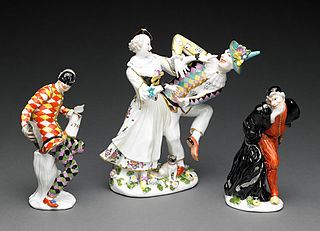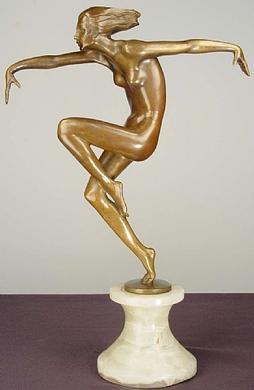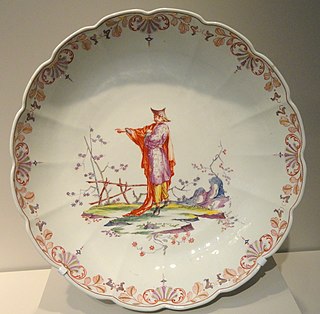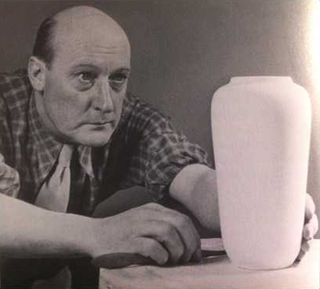History
In 1885, Friedrich Goldscheider came from the Bohemian city of Plzeň to Vienna and founded the Goldscheider Porcelain Manufactory and Majolica Factory. It became one of the most influential ceramic manufactories of terracotta, faience and bronze objects in Austria, with subsidiaries in Paris, Leipzig and Florence. For over half a century, Goldscheider created masterpieces of historical revivalism, Art Nouveau (Jugendstil) and Art Deco.
Famous artists such as Josef Lorenzl, Stefan Dakon, Ida Meisinger and the two perhaps best known Austrian ceramic artists, Michael Powolny and Vally Wieselthier, worked for Goldscheider. Several of the artists who worked for Goldscheider also worked for other Viennese studios, such as Augarten, Keramos or for the German brands Rosenthal and Meissen.
The Goldscheider family migrated in 1938 to the United Kingdom and the USA. Walter Goldscheider started a new factory in Trenton, New Jersey, and he returned to Vienna in 1950. Marcel Goldscheider went to Stoke-on-Trent and produced figurative ceramics for Myott, and he opened his own studio in the 1950s in Hanley. Both brothers died in the early 1960s.
More than 10,000 different models were created over a period of three generations. Since the very beginning, many of these won first prizes and gold medals at innumerable world fairs, exhibitions and trade fairs. Goldscheider figures are nowadays very much sought after by collectors worldwide and reach astonishing prices at auctions such as Sotheby's, Christie's, Dorotheum and on eBay.
The son of Friedrich Goldscheider, Arthur Goldscheider [ de ] was an art publisher in Paris during the Art Deco-era.

Porcelain is a ceramic material made by heating raw materials, generally including kaolinite, in a kiln to temperatures between 1,200 and 1,400 °C. The greater strength and translucence of porcelain, relative to other types of pottery, arise mainly from vitrification and the formation of the mineral mullite within the body at these high temperatures. End applications include tableware, decorative ware such as figurines, toilets and washbasins, and products in technology and industry such as electrical insulators and laboratory ware.

Faience or faïence is the general English language term for fine tin-glazed pottery. The invention of a white pottery glaze suitable for painted decoration, by the addition of an oxide of tin to the slip of a lead glaze, was a major advance in the history of pottery. The invention seems to have been made in Iran or the Middle East before the ninth century. A kiln capable of producing temperatures exceeding 1,000 °C (1,830 °F) was required to achieve this result, the result of millennia of refined pottery-making traditions. The term is now used for a wide variety of pottery from several parts of the world, including many types of European painted wares, often produced as cheaper versions of porcelain styles.

Meissen porcelain or Meissen china was the first European hard-paste porcelain. Early experiments were done in 1708 by Ehrenfried Walther von Tschirnhaus. After his death that October, Johann Friedrich Böttger continued von Tschirnhaus's work and brought this type of porcelain to the market, financed by Augustus the Strong, King of Poland and Elector of Saxony. The production of porcelain in the royal factory at Meissen, near Dresden, started in 1710 and attracted artists and artisans to establish, arguably, the most famous porcelain manufacturer known throughout the world. Its signature logo, the crossed swords, was introduced in 1720 to protect its production; the mark of the swords is reportedly one of the oldest trademarks in existence.

Mintons was a major company in Staffordshire pottery, "Europe's leading ceramic factory during the Victorian era", an independent business from 1793 to 1968. It was a leader in ceramic design, working in a number of different ceramic bodies, decorative techniques, and "a glorious pot-pourri of styles - Rococo shapes with Oriental motifs, Classical shapes with Medieval designs and Art Nouveau borders were among the many wonderful concoctions". As well as pottery vessels and sculptures, the firm was a leading manufacturer of tiles and other architectural ceramics, producing work for both the Houses of Parliament and United States Capitol.

Zsolnay, or formally Zsolnay Porcelánmanufaktúra Zrt is a Hungarian manufacturer of porcelain, tiles, and stoneware. The company introduced the eosin glazing process and pyrogranite ceramics.

The Herend Porcelain Manufactory is a Hungarian manufacturing company, specializing in luxury hand-painted and gilded porcelain. Founded in 1826, it is based in the town of Herend near the city of Veszprém.

The Bröhan Museum is a Berlin state museum for Art Nouveau, Art Deco, and Functionalism, located in Berlin's Charlottenburg district. The Museum is named after its founder, entrepreneur and art collector Karl. H. Bröhan (1921–2000), who donated his collection to the state of Berlin on the occasion of his 60th birthday. In 1983, the Bröhan Museum opened in its current space, which belongs to the Charlottenburg Palace ensemble and was originally built for the guard regiment. Since 1994, it has been a state museum.
Stefan Dakon (1904–1992) was an Austrian artist who worked in close association with Josef Lorenzl, producing many exciting bronze figurine sculptures of the Art Deco period. Dakon's models were used among others by members of the association of bronze producers "Wiener Bronzen", as well as by the famous ceramics manufacturer Goldscheider from Vienna. He also designed models for the Austrian ceramics manufacturer Keramos.

Josef Lorenzl was an Austrian sculptor and ceramicist of the Art Deco period, the same era as Ferdinand Preiss (1882–1943) and Demetre Chiparus (1886–1947).
Walter Bosse was a Viennese artist, designer, ceramist, potter, metalworker, and craftsman noted for his modernist bronze animal figurines and grotesques.

Margarete Heymann, also known as Margarete Heymann-Löbenstein, Margarete Heymann-Marks, and Grete Marks, was a German ceramic artist of Jewish origin and a Bauhaus student. In 1923 she founded the Haël Workshops for Artistic Ceramics at Marwitz that she had to close in 1933 and settled in Jerusalem. She moved to Britain in 1936 and continued her work, becoming world famous as “Greta Pottery”. Her finest work is considered to be from her working period in Germany.

Roma Babuniak is an artist whose work is associated with bone china and unglazed biscuit porcelain. She lives and works in Germany and France She has won many prizes and awards, in 1986, the 1st International Ceramics Contest Mino, Japan, and the 1999 Premio Diputacio da Valencia; International BiennalManises, Museu de ceramic de Manises, Spain among others.

Maria Baumgartner is an Austrian studio potter and was professor of ceramics at the University of Arts and Industrial Design Linz.

Vienna porcelain is the product of the Vienna Porcelain Manufactory, a porcelain manufacturer in Alsergrund in Vienna, Austria. It was founded in 1718 and continued until 1864.
Marcel Bouraine (1886–1948) was a French sculptor. He is known for his work in the Art Deco-era, specifically small statuettes, lamps, bookends, and radiator figures.

Jan Bontjes van Beek was a German ceramicist, sculptor and dancer.

Valerie "Vally" Wieselthier was an Austrian-American ceramic artist.

Helmut Leherb was an Austrian artist and representative of the Vienna School of Fantastic Realism, which is close to Surrealism. He was born Helmut Leherbauer in Vienna and is also known as Maître Leherb.

Ena Rottenberg was a Hungarian-Austrian craftswoman, draftswoman, ceramist and member of the artists' community of the Wiener Werkstätte.

The Museum Giuseppe Gianetti is a ceramics museum located in Saronno, Italy. The Museum includes collections of different types of porcelain, majolica, and ceramics that belonged to the Italian industrialist Giuseppe Gianetti. These showcase more than 200 pieces of Meissen porcelain, which represents the Museum's most substantial collection. Other collections cover Oriental porcelain, Italian and European majolica, and porcelain. The original collections have been expanded to include the Aldo Marcenaro Collection and a collection of contemporary ceramics.


















